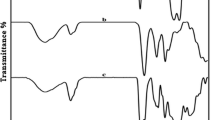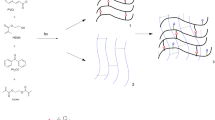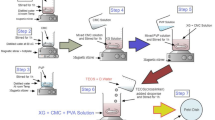Abstract
Poly(N-vinyl pyrrolidone-co-n-butyl methacrylate) P(NVP-co-nBMA) copolymers containing high N-vinyl pyrrolidone content were crosslinked to increase their hydro-stable nature for controlled drug delivery. Diethylene glycol dimethacrylate (DEGDMA) and trimethylolpropane trimethacrylate (TMPTMA) were used as crosslinkers. The effect of crosslinker concentration and functionality on gel content, thermal stability and water uptake at 37 °C was investigated. The gel contents and thermal stability increased while water uptake decreased with increasing concentration and functionality of crosslinker. The copolymer crosslinked by TMPTMA showed good mechanical properties. The porous network structure of the copolymers was confirmed by scanning electron microscopic studies. Dexamethasone was selected as a model drug and its controlled release was observed for 22 days from TMPTMA crosslinked copolymer (NB91-T2) film, whereas 96 % drug was released in 35 days for DEGDMA crosslinked copolymer (NB91-D2) film. The kinetics of 10 h drug release identified first-order drug release for NB91-D2 and Higuchi kinetics for NB91-T2. The initial 60 % drug release followed non-Fickian diffusion mechanism. These results indicate the future application of NB91-D2 and NB91-T2 copolymer films as a drug carrier for implant coatings.









Similar content being viewed by others
References
Yeh JT, Chen CL, Huang KS, Nien YH, Chen JL, Huang PZ (2006) Synthesis, characterization and application of PVP/chitosan blended polymers. J Appl Polym Sci 101:885–891
Brar AS, Kumar R (2002) Sequencing of N-vinyl-2-pyrrolidone/glycidyl methacrylate copolymers by one-dimensional and two-dimensional nuclear magnetic resonance spectroscopy. J Appl Polym Sci 84:50–60
Ahmad B, Bashir S, Nisa S, Huglin MB (2004) Chemically crosslinked N-vinyl-2-pyrrolidone/2-hydroxyethyl methacrylate (VP/HEMA) copolymer for the controlled release of cyclic oligopeptide. Turk J Chem 28:279–285
Sadeghi M, Soleimani F, Shahsavari H, Ghasemi N (2012) Optimization of effective parameters onto synthesis and swelling behavior of macromolecules hydrogels based on carboxymethylcellulose. J Basic Appl Sci Res 2:769–776
Hanssen HHL, Wetzels GMR et al (1999) Metallic wires with an adherent lubricious and blood-compatible coating and their use in the manufacture of novel slippery-when-wet guidewires: possible applications related to controlled local drug delivery. J Biomed Mater Res 48:820–828
Leon MB, Abizaid A, Mosses JW (2003) The CYPHER™ stent: a new gold standard in the treatment of coronary artery disease. The Cardiovascular Research Foundation, New York, p 90
Patel MP, Pearson GJ, Braden M, Mirza MA (1998) Fluoride ion release from two methacrylate polymer systems. Biomaterials 19:1911–1917
Islam A, Yasin T (2012) Controlled delivery of drug from pH sensitive chitosan/poly(vinyl alcohol) blend. Carbohydr Polym 88:1055–1060
Fratoddi I, Venditti I, Cametti C, Palocci C, Chronopoulou L, Marino M, Acconcia F, Russo MV (2012) Functional polymeric nanoparticles for dexamethasone loading and release. Colloids Surf B Biointerfaces 93:59–66
Kim J, Chauhan A (2008) Dexamethasone transport and ocular delivery from poly(hydroxyethyl methacrylate gels. Int J Pharm 353:205–222
Song CX, Labhasetwar V, Murphy H, Qu X, Humphrey WR, Shebuski RJ, Levy RJ (1997) Formulation and characterization of biodegradable nanoparticles for intravascular local drug delivery. J Control Release 43:197–212
Kenyon CJ, Nardi RV, Wong D, Hooper G, Wilding IR, Friend DR (1997) Colonic delivery of dexamethasone: a pharmacoscintigraphic evaluation. Aliment Pharmacol Ther 11:205–213
Mukherjee B, Mahapatra S, Gupta R, Patra B, Tiwari A, Arora P (2005) A comparison between povidone–ethylcellulose and povidone–eudragit transdermal dexamethasone matrix patches based on in vitro skin permeation. Eur J Pharm Biopharm 59:475–483
Jin L, Lu P, You H, Chen Q, Dong J (2009) Vitamin B12 diffusion and binding in crosslinked poly(acrylic acid)s and poly(acrylic acid-co-N-vinyl pyrrolidinone)s. Int J Pharm 371:82–88
Broido A (1969) A simple, sensitive graphical method of treating thermogravimetric analysis data. J Polym Sci A-2 Polym Phys 7:1761–73
Huma F, Akhter Z, Zafar-Uz-Zaman M, Yasin T (2013) Release of dexamethasone from poly(N-vinyl pyrrolidone-co-n-hexyl methacrylate copolymers of controlled hydrophilicity. J Appl Polym Sci 128:444–450
Honary S, Hoseinzadeh B, Shalchian P (2010) The effect of polymer molecular weight on citrate crosslinked chitosan films for site-specific delivery of a non polar drug. Trop J Pharm Res 9:525–531
Geever LM, Devine DM, Nugent MJD, Kennedy JE, Lyons JG, Higginbotham CL (2006) The synthesis, characterization, phase behavior and swelling of temperature sensitive, physically crosslinked poly(1-vinyl-2-pyrrolidone)/poly(N-isopropylacrylamide) hydrogels. Eur Polym J 42:69–80
Wu YH, Freeman BD (2009) Structure, water sorption, and transport properties of crosslinked N-vinyl-2-pyrrolidone/N, N′-bismethacrylamide films. J Membr Sci 344:182–189
Száraz I, Forsling W (2000) A spectroscopic study of the salvation of 1-vinyl-2-pyrrolidone and poly(1-vinyl-2-pyrrolidone) in different solvents. Polymer 41:4831–4839
Dutta K, Brar AS (1999) Poly(vinylpyrrolidone): configurational assignments by one- and two-dimensional NMR spectroscopy. J Polym Sci Part A Polym Chem 37:3922–3928
Ibrahim K, Löfgren B, Seppälä J (2003) Towards more controlled poly(n-butyl methacrylate) by atom transfer radical polymerization. Eur Polym J 39:939–944
Bianco G, Soldi MS, Pinheiro EA, Pires ATN, Gehlen MH, Soldi V (2003) Thermal stability of poly(N-vinyl-2-pyrrolidone-co-methacrylic acid) copolymers in inert atmosphere. Polym Degrad Stab 80:567–574
Jones DS, Djokic J, McCoy CP, Gorman SP (2002) Poly(ε-caprolactone) and poly(ε-caprolactone)–polyvinylpyrrolidone–iodine blends as ureteral biomaterials: characterization of mechanical and surface properties, degradation and resistance to encrustation in vitro. Biomaterials 23:4449–4458
Mano JF, Vaz CM, Mendes SC, Reis RL, Cunha AM (1999) Dynamic mechanical properties of hydroxyapatite-reinforced and porous starch-based biodegradable biomaterials. J Mater Sci Mater Med 10:857–862
Adhyapak A, Desai BG (2011) Preparation and in vitro characterization of the transdermal drug delivery system containing tamoxifen citrate for breast cancer. Asian J Pharm 5:41–45
Hong Y, Chirila TV, Cuypers MJ, Constable IJ (1996) Polymers of 1-vinyl-2-pyrrolidinone as potential vitreous substitutes: physical selection. J Biomater Appl 11:135–181
Davis TP, Huglin MB (1991) Effect of crosslinking on the properties of poly(2-hydroxyethyl methacrylate) hydrogels. Angew Makromol Chem 189:195–205
Jansook P, Ritthidej GC, Ueda H, Stefánsson E, Loftsson T (2010) γCD/HPγCD mixtures as solubilizer: solid-state characterization and sample dexamethasone eye drop suspension. J Pharm Pharm Sci 13:336–350
Tickler WJ, Nagvekar AA, Dash AK (2008) A novel nanoparticle formulation for sustained paclitaxel delivery. AAPS Pharm Sci Tech 9:486–493
Fan LT, Singh SK (1989) Controlled release: a quantitative treatment. Springer, Berlin
Mathew ST, Devi SG, Sandhya KV (2007) Formulation and evaluation of ketorolac tromethamine-loaded albumin microspheres for potential intramuscular administration. AAPS Pharm Sci Tech 8:E100–E108
Korsmeyer RW, Gurny R, Doelker E, Buri P, Peppas NA (1983) Mechanisms of solute release from porous hydrophilic polymers. Int J Pharm 15:25–35
Author information
Authors and Affiliations
Corresponding author
Rights and permissions
About this article
Cite this article
Huma, F., Akhter, Z., Yasin, T. et al. Crosslinking of poly(N-vinyl pyrrolidone-co-n-butyl methacrylate) copolymers for controlled drug delivery. Polym. Bull. 71, 433–451 (2014). https://doi.org/10.1007/s00289-013-1069-y
Received:
Revised:
Accepted:
Published:
Issue Date:
DOI: https://doi.org/10.1007/s00289-013-1069-y




